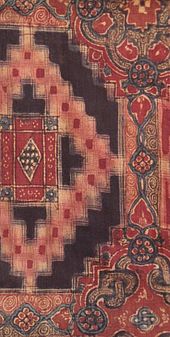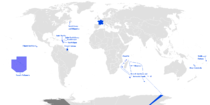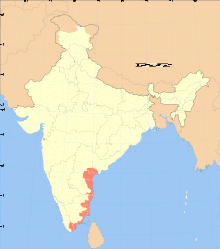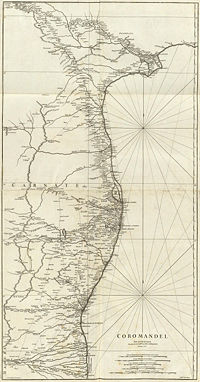- Coromandel Coast
-
This article is about the Coromandel Coast of India. For the similarly named region in New Zealand, see Coromandel Peninsula.
The Coromandel Coast (Tamil: சோழ மண்டலக் கடற்கரை) is the name given to the southeastern coast of the Indian Subcontinent between Cape Comorin and False Divi Point. It may also include the southeastern coast of the island of Sri Lanka.
Contents
Etymology
The land of the Chola dynasty was called Cholamandalam (சோழ மண்டலம்) in Tamil, literally translated as The realm of the Cholas, from which Coromandel is derived.[1][2][3] Another research shows that the coast along the Chola country was called Cholamandalam which was later corrupted to Coromandel by the Europeans.[4] According to The Periplus of the Erythræan Sea by Wilfred Harvey Schoff, the Chola coast was derived from the native Tamil name Chola-mandalam, from which the Portuguese derived our modern word Coromandel.[5]
Description
The coast is generally low, and punctuated by the deltas of several large rivers, including the Kaveri (Cauvery), Palar, Penner, and Krishna, which rise in the highlands of the Western Ghats and flow across the Deccan Plateau to drain into the Bay of Bengal. The alluvial plains created by these rivers are fertile and favour agriculture. The coast is also known for its ports and harbours, Pulicat, Chennai (Madras), Sadras, Pondicherry, Karaikal, Cuddalore, Tranquebar, Nagore, and Nagapattinam, which take advantage of their close proximity with regions rich in natural and mineral resources (like the Chhattisgarh belt and the mines of Golconda and Kolar) and/or good transport infrastructure. The planar geography of the region also favours urban growth and agglomerations.
The Coromandel Coast falls in the rain shadow of the Western Ghats, and receives a good deal less rainfall during the summer southwest monsoon, which contributes heavily to rainfall in the rest of India. The region averages 800 mm/year, most of which falls between October and December. The topography of the Bay of Bengal, and the staggered weather pattern prevalent during the season favours northeast monsoon, which has a tendency to cause cyclones and hurricanes rather than a steady precipitation. As a result, the coast is hit by inclement weather almost every year between October to January. The high variability of rainfall patterns are also responsible for water scarcity and famine in most areas not served by the great rivers. For example, the city of Chennai is one of the driest cities in the country in terms of potable water availability, despite high percentage of moisture in the air, due to the unpredictable, seasonal nature of the monsoon.
The Coromandel Coast is home to the East Deccan dry evergreen forests ecoregion, which runs in a narrow strip along the coast. Unlike most of the other tropical dry forest regions of India, where the trees lose their leaves during the dry season, the East Deccan dry evergreen forests retain their leathery leaves year round. The Coromandel coast is also home to extensive mangrove forests along the low-lying coast and river deltas, and several important wetlands, notably Kaliveli Lake and Pulicat Lake, that provide habitat to thousands of migrating and resident birds.
History
 Sarasa chintz from the Coromandel Coast, 17th or 18th century, made for the Japanese market. Private collection, Nara Prefecture.
Sarasa chintz from the Coromandel Coast, 17th or 18th century, made for the Japanese market. Private collection, Nara Prefecture.
By late 1530 the Coromandel Coast was home to three Portuguese settlements at Nagapattinam, São Tomé de Meliapore, and Pulicat. Later, in the 17th and 18th century, the Coromandel Coast was the scene of rivalries among European powers in the seventeenth and eighteenth centuries for control of the India trade. The British established themselves at Fort St George (Madras) and Masulipatnam, the Dutch at Pulicat, Sadras and Covelong, the French at Pondicherry, Karaikal and Nizampatnam, the Danish in Dansborg at Tharangambadi.
Eventually the British won out, although France retained the tiny enclaves of Pondicherry and Karaikal until 1954. Chinese lacquer goods, including boxes, screens, and chests, became known as "Coromandel" goods in the eighteenth century, because many Chinese exports were consolidated at the Coromandel ports.
On December 26, 2004, one of the deadliest natural disasters in modern history, the Indian Ocean earthquake, struck off the western coast of Sumatra (Indonesia). The earthquake and subsequent tsunami reportedly killed over 220,000 people around the brim of the Indian Ocean. The tsunami devastated the Coromandel Coast, killing many and sweeping away many coastal communities.
Applications of the name
Four ships of the British Royal Navy bore the name HMS Coromandel, after the Indian coast. The Coromandel Peninsula in New Zealand was named after one of these ships, and the town of Coromandel, New Zealand - after the peninsula. A red nail varnish made by Chanel is named coromandel due to its suggestions of exoticism. One of the earliest superfast trains of Indian Railways that runs between Howrah and Chennai is named Coromandel Express.
In literature
The 1955 historical novel Coromandel! by John Masters describes a young English adventurer arriving in the 17th Century at the Coromandel Coast - the founder of the Savage family, whose descendants' lives at various periods of British rule in India appear in other books of Masters' series.
Also, the little-known early 20th-century poet Walter J. Turner wrote a poem entitled 'Coromandel'.
"The Courtship Of The Yonghy-bonghy-bo" by Edward Lear is set on the Coast of Coromandel.
Coromandel Wood is referred to by Dame Edith Sitwell in her poem "Black Mrs Behemoth", part of "Façade", the grain of which, she likened to the rolling, curling smoke of a blown out candle. Her brother, Sir Osbert Sitwell composed a poem entitled "On the coast of Coromandel".
References
- ^ The Land of the Tamulians and Its Missions, by Eduard Raimund Baierlein, James Dunning Baker
- ^ South Indian Coins - Page 61 by T. Desikachari - Coins, Indic - 1984
- ^ Indian History - Page 112
- ^ Annals of Oriental Research - Page 1 by University of Madras - 1960
- ^ The Periplus of the Erythræan Sea by Wilfred Harvey Schoff
- WorldStatesmen- India
Mountains and Plateaus Himalayas · Western Ghats · Eastern Ghats · Aravalli Range · The Nilgiris · Vindhya Range · Satpura Range · Garo Hills · Shivalik Hills · Mahabharat Range · Khasi Hills · Annamalai Hills · Cardamom Hills · Sulaiman Mountains · Toba Kakar Range · Karakoram · Hindu Kush · Chittagong Hill Tracts · Deccan Plateau · Thar Desert · Makran · Chota Nagpur · Naga Hills · Mysore Plateau · Ladakh Plateau · Gandhamardan HillsLowlands and Islands Indo-Gangetic plain · Indus River Delta · Ganges Basin · Ganges Delta · Terai · Atolls of Maldives · Coromandel Coast · Konkan · Lakshadweep · Andaman and Nicobar Islands · Sundarbans · Greater Rann of Kutch · Little Rann of Kutch · Protected areas in Tamil NaduCountries Danish overseas colonies and territories Former colonies 
Current overseas
territoriesDutch Empire Colonies and trading posts of the Dutch East India Company (1602-1798) GovernoratesAmbon · Banda · Batavia · Cape Colony · Ceylon · Coromandel · Formosa · Northeast coast of Java · Makassar · Malacca · MoluccasDirectoratesCommandmentsResidenciesSettlements with an opperhoofdColonies and trading posts of the Dutch West India Company (1621-1792) Colonies in the AmericasAcadia · Berbice† · Cayenne · Curaçao and Dependencies · Demerara · Essequibo · Brazil · New Netherland · Pomeroon · Sint Eustatius and Dependencies · Suriname‡ · Tobago · Virgin IslandsTrading posts in Africa† Governed by the Society of Berbice · ‡ Governed by the Society of SurinameSettlements of the Noordsche Compagnie (1614-1642) SettlementsColonies of the Kingdom of the Netherlands (1815-1962) Until 1825Until 1853Until 1872Until 1945Until 1954Until 1962† Became constituent countries of the Kingdom of the Netherlands; Suriname gained full independence in 1975, Curaçao and Dependencies was renamed to the Netherlands Antilles, which was eventually dissolved in 2010.Kingdom of the Netherlands (1954-Present) Constituent countriesPublic bodies of the NetherlandsFrench overseas empire Former Former French colonies in Africa and the Indian Ocean Maghreb - Algeria
- Morocco (Arguin Island)
- Tunisia
French West Africa French Equatorial Africa Comoros - French Somaliland (Djibouti)
- Madagascar
- Ile de France
- Seychelles
Former French colonies in the Americas Inini · Berbice · Saint-Domingue (Haiti) · Tobago · Virgin Islands · France Antarctique · Equinoctial FranceFormer French colonies in Asia and Oceania French India Indochinese Union French Mandate for Syria and the Lebanon Oceania France-Asia relations · French East India CompanyPresent  Overseas departments and territories of France
Overseas departments and territories of FranceInhabited areas  Special status
Special statusUninhabited areas Pacific Ocean French Southern and
Antarctic LandsBanc du Geyser4 · Bassas da India4 · Europa Island4 · Glorioso Islands3, 4, 5 · Juan de Nova Island4 · Tromelin Island4, 51 Also known as overseas regions. 2 Claimed by Comoros. 3 Claimed by Madagascar. 4 Claimed by Seychelles. 5 Claimed by Mauritius.Categories:- South India
- Regions of India
- Former Danish colonies
- Regions of Andhra Pradesh
- Former Dutch colonies
- Former colonies of France
Wikimedia Foundation. 2010.


